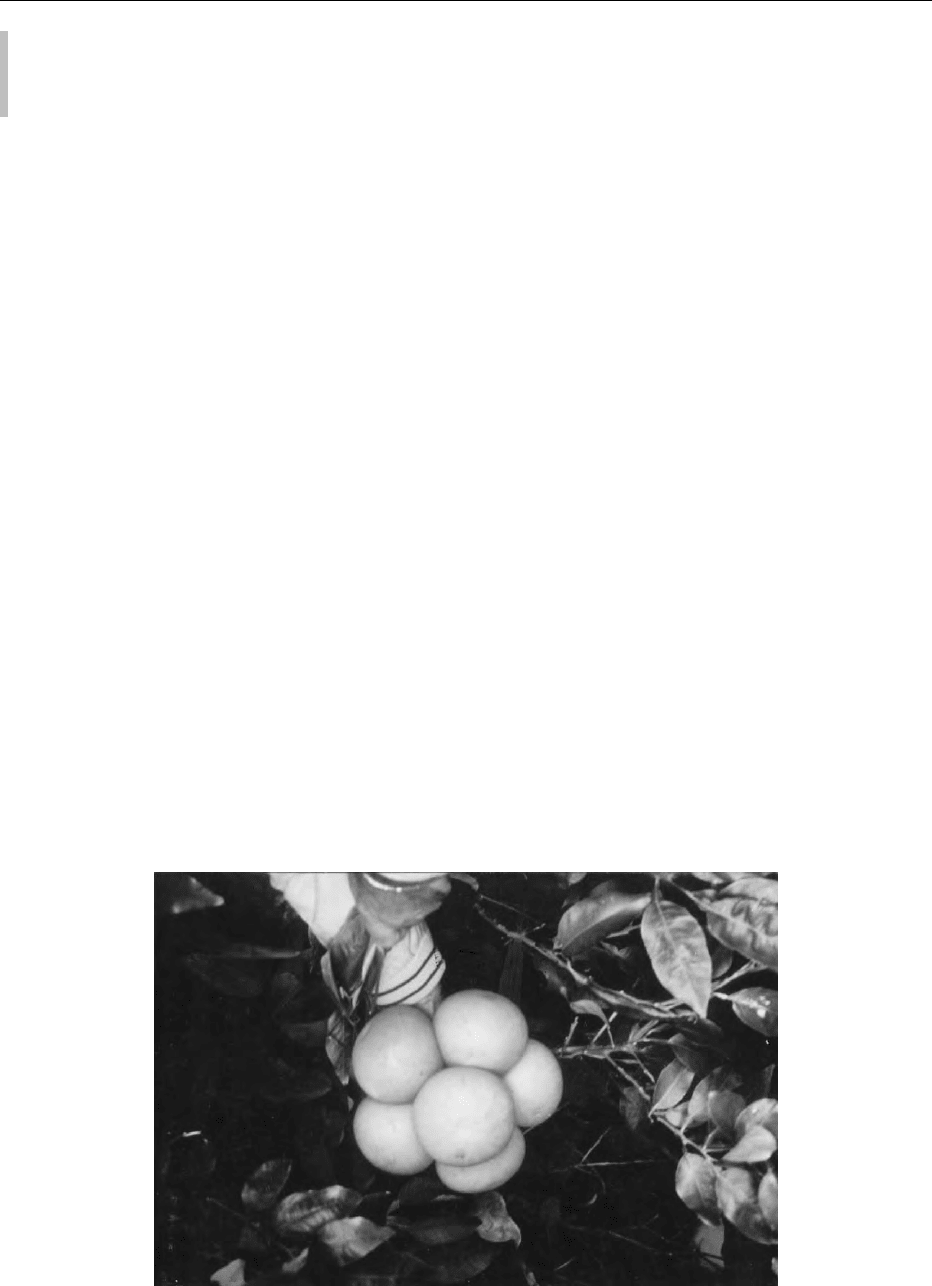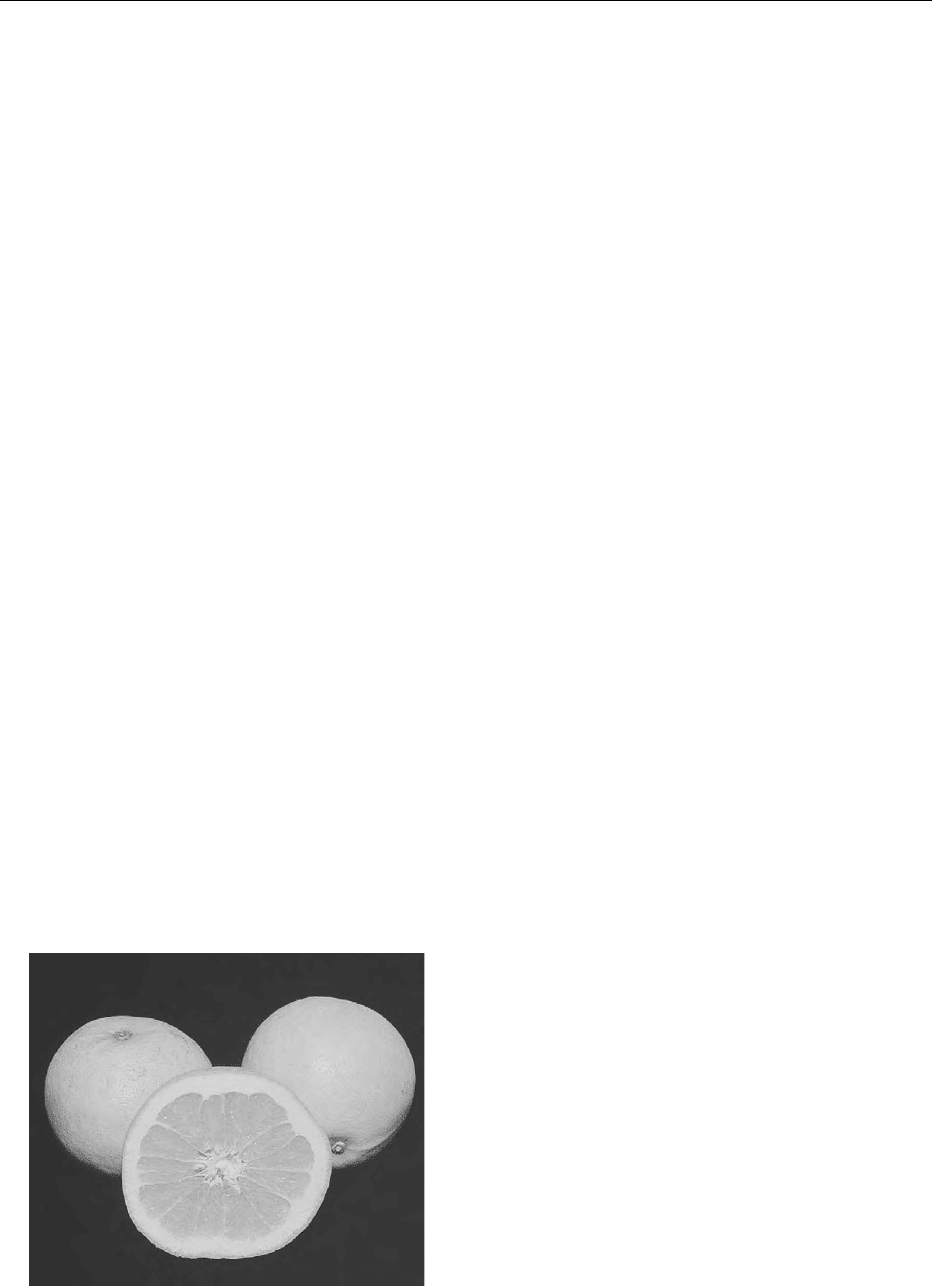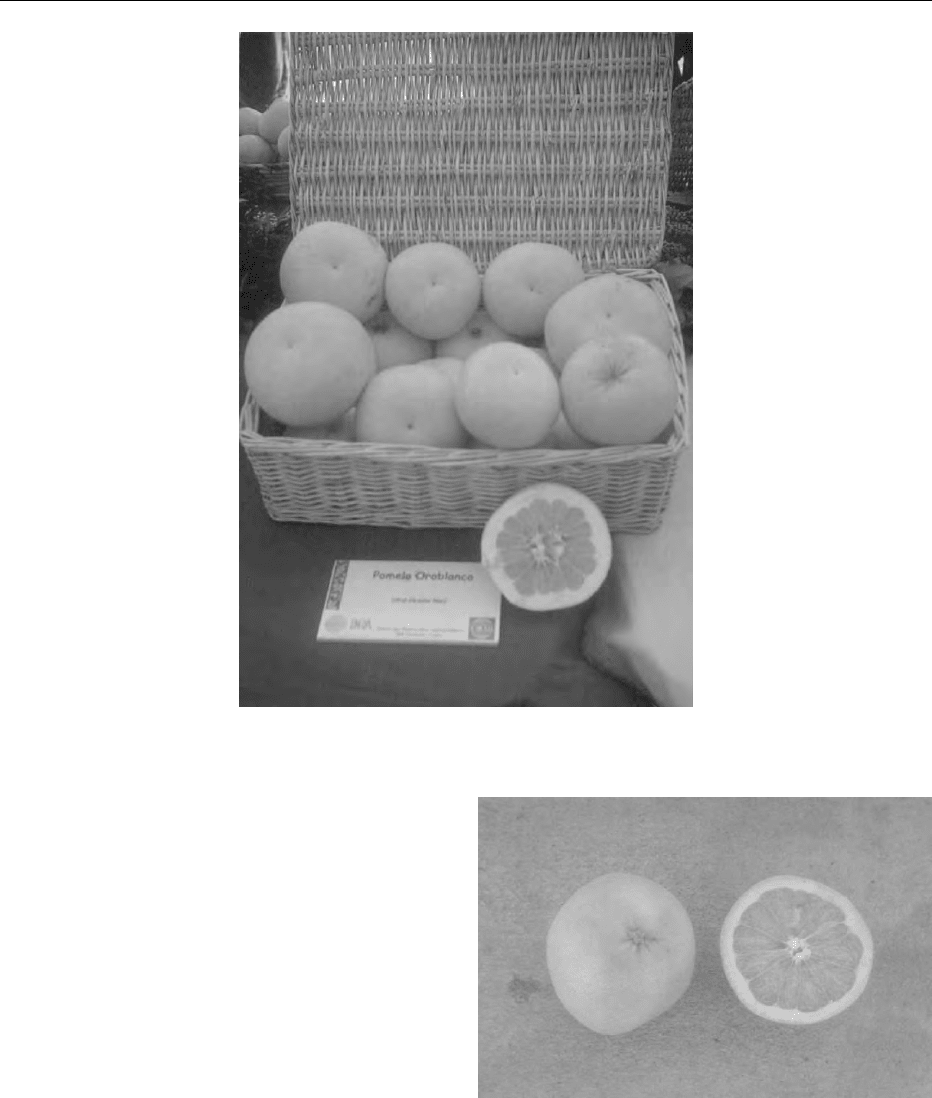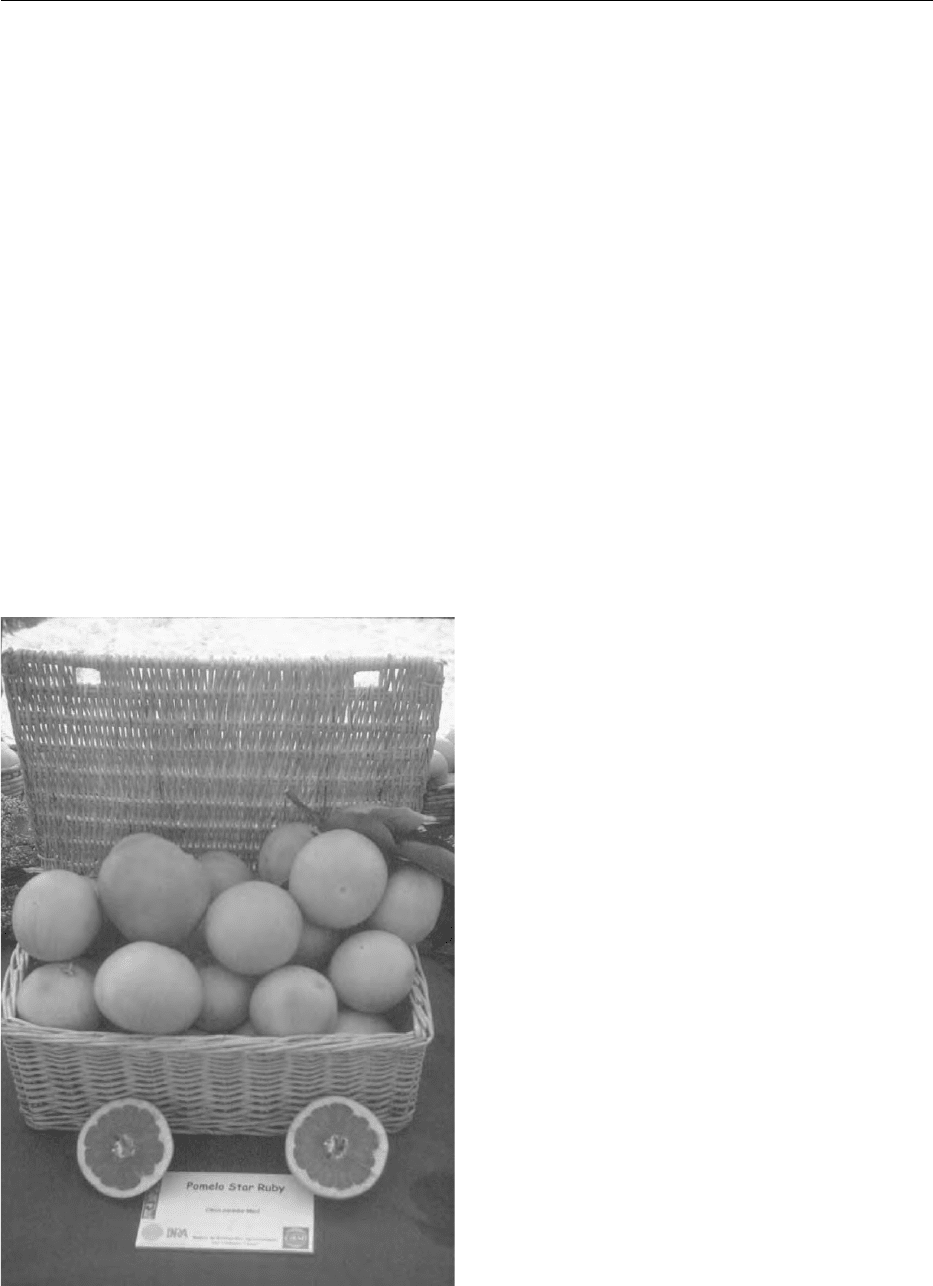Caballero B. (ed.) Encyclopaedia of Food Science, Food Technology and Nutrition. Ten-Volume Set
Подождите немного. Документ загружается.


sunburn and possibly freeze damage. The Eureka
tree, however, is less thorny than the Lisbon and
thus easier to pick. The Eureka tree also appears to
be more susceptible to cold damage, making it most
suitable for the coastal areas of California and Aus-
tralia, where freezes seldom occur. The two fruits,
however, are very similar, and processors in particular
have difficulty in differentiating the two.
0008 The Mesero lemon, of Spanish origin but grown
more commonly in Italy, is considered one of the best
processing lemons; it has a smooth, thin, somewhat
pale rind, but contains a large amount of juice. Con-
versely, the Interdonato is primarily a fresh cultivar,
with a lower juice content and a smooth, thin rind. The
fruit itself is large, and the flesh contains few seeds.
0009 Winter is the main harvest for Verna fruit grown in
Spain, Algeria, and Morocco. However, in Spain,
where Verna is the primary cultivar, a significant
supply of fruit is kept available for harvest through-
out much of the summer, a peak season for lemon
demand. The Femminello, a name for an everbearing
group of cultivars grown in the Mediterranean coun-
tries, has its main crop reaching maturing in the late
winter and early spring but is also marketed through-
out the year. Interestingly, in Italy, each particular
lemon crop has its own name, and is marketed
according to season instead of by the varietal name.
Thus, the Primofiore is from the September through
November harvest, the Limoni is from December to
May, the Bianchetti is from the April to June harvest,
and the Verdelli is from the June to September har-
vest. Collectively, this group accounts for about 75%
of the lemons grown in Italy. Most (over 90%) of the
lemons grown in Italy are produced in the coastal
area of Sicily, a warm, dry climate that is highly
favorable for lemon production The Interdonoto, an-
other Mediterranean cultivar, is harvested in the fall
and early winter. This cultivar is a significant portion
of Turkey’s lemon crop.
0010 The Genova is grown principally in South America
and is the leading variety in Chile. The fruit has a
good internal quality (high acid, flavor, and juice
yield), similar to Eureka, and a characteristic spher-
ical shape. The origin of Genova is Italy, and it is
actually considered a strain of Eureka in California,
where it was first imported from Italy in the late
nineteenth century.
0011 Compared to other citrus, the projected production
growth of lemons is forecast to be only modest, with
an estimated rate of 1.5% per annum into 2005. This
is about half the growth of the previous decade. The
geographic production will also shift, with the
strongest production growth forecast for Italy and
Argentina, and with possible crop reductions in
California.
Fruit Structure and Chemistry
0012The structure of the lemon fruit is similar to other
citrus and consists of the peel and the interior edible
portion (endocarp or pulp). The peel is composed of
two distinct layers; the outside layer is termed
the flavedo (epicarp), and the interior of the peel
(the white spongy part) is the albedo (mesocarp).
The many chemical constituents of the lemon fruit
are distributed among the various tissues, usually in
differing concentrations. The flavedo is composed of
mainly carotenoid pigments, vitamins, and essential
oils. The green appearance of immature lemon fla-
vedo is due to the predominance of chlorophyl over
the carotenoid pigments prior to complete ripening.
The albedo contains celluloses and soluble carbohy-
drates, pectin and protopectin, flavonoids, amino
acids, and vitamins. The oil glands, containing the
valuable essential oil, are embedded primarily in
the flavedo, although larger oil glands may also
extend through to the upper part of the albedo.
0013The pulp of the lemon fruit, like other citrus, is
divided into segments called carpels. Each segment
is composed of up to several hundred units called
juice sacs or vesicles. These vesicles are the compart-
ments, which contain the actual lemon juice. The
walls of the vesicles are composed of celluloses, hemi-
celluloses, pectin, protopectin, sugars, flavonoids,
and other minor components such as amino acids
and vitamin C. When intact, the vesicles effectively
contain the juice and limit microbial and enzymatic
degradation of the juice.
0014Comparisons of California fruit (navel and Valen-
cia oranges, and lemons) show that, in relation to the
oranges, lemons have a somewhat lower protein con-
tent, a substantially lower sugar content, and a much
higher acid content. These biochemical measure-
ments of the fruit, confirmed by obvious taste charac-
teristics, lead to the categorization of citrus by
horticulturalists as either low-acid (oranges, manda-
rins and grapefruit) or high-acid (lemons and limes)
fruit. Lemon juice contains about 4.3–4.8 g citric acid
per 100 ml, as compared to around 0.8–1.0 g per
100 ml for mandarin, orange, or grapefruit juices.
0015Fresh lemon juice has approximately the following
vitamin levels per 100 g: b-carotene, 12 mg; thiamin,
0.3 mg; riboflavin, 0.01 mg; vitamin B
6
, 0.05 mg;
folate, 13 mg; and vitamin C, 36 mg. These figures
vary depending on the source of the fruit and process-
ing and storage conditions.
0016The peel and seeds of all citrus are relatively rich in
phenolic compounds such as flavonoids and phenolic
acids. Phenolic compounds are known, potent anti-
oxidants. Citrus flavonoids include polymethoxy-
lated flavones and glycosylated flavanones; both are
1356 CITRUS FRUITS/Lemons

unique to citrus and are thought to have bioactive
properties such as anticancer, antiinflammatory, and
antiviral effects, among others. Methanol extracts of
lemon seeds are rich in eriocitrin and hesperidin,
while peel extracts contain significant amounts of
neoeriocitrin, naringin, and neohesperidin. There
are many ongoing research programs investigating
the functional properties of these flavonoids, and
other bioactive compounds in all citrus, including
lemon.
0017 All fruits and fruit products contain a range of
volatile, low-molecular-weight (< 250) compounds
that are important in producing the characteristic
flavor and aroma of the specific fruit. The predomin-
ant compounds responsible for lemon aroma number
are relatively few (two to five) compared to other
citrus. The most important component is citral, an
aldehyde that is a cis–trans mixture of the isomers
neral and geranial. Table 3 summarizes some volatile
compounds found in commercial lemon oils and
essences.
Postharvest Handling and Fruit for the
Fresh Market
0018 In the past, the USA, Italy, and Spain dominated total
lemon production, and, as noted in Table 1, Argen-
tina has become a major producer. For fresh fruit
markets, Spain has the major and profitable role in
supplying fresh lemon fruit to Western Europe and
other markets; the USA, Argentina, and Italy con-
tinue to process about half of their fruit and market
the other half as fresh fruit.
0019 Two terms must be understood in order to discuss
citrus fruit quality, markets, and economics: grade
and maturity. The grade refers to external character-
istics such as size, presence of blemishes, and appear-
ance, while maturity refers to mostly internal
characteristics such as juice content, taste, total sol-
uble solids (TSS), acid content (titratable acidity; TA)
and the ratio of TSS to TA. As with most produce
destined for the fresh market, appearance is the pri-
mary attribute of quality for fresh market lemons,
and grading is critical and standardized in a given
country or region. Consumers may make repurchas-
ing decisions based upon internal quality, but gener-
ally will not choose a fruit initially if it presents
exterior faults. Areas with hot, dry summers and
cool, wet winters (Mediterranean climate) typically
produce citrus fruit with brighter, thicker peel than
areas with more humid growing seasons and warmer
winter nights. The Mediterranean climate is also as-
sociated with generally better exterior fruit appear-
ance (at the same level of inputs such as fertilizer and
pesticides) than fruit grown in a humid climate and is
yet another reason for the predominance of fresh
market lemon production in the Mediterranean-type
climate. Quality indices include color intensity and
uniformity; size (larger lemons are preferred), visually
pleasing shape and smoothness; freedom from obvi-
ous decay and damage; and freedom from exterior
blemishes, splotches, and rind discoloration. Fresh-
fruit pricing in most lemon-producing countries is
based on these factors, along with market supply
and demand.
0020Lemons for both the fresh and processed markets
are harvested manually. Pickers use bags, ladders,
clippers, and gauges to judge the size of the fruit.
Fruit picked early in each variety’s particular growing
season may be quite green, even though they may be
deemed physiologically mature. Lemons picked while
still green will generally have a longer postharvest
shelf-life than the fully yellow lemons that need to
be handled gently and marketed more rapidly. Young
lemons can be degreened at the packing house, if
necessary. Degreening is accomplished by exposing
the lemons to 1–10 p.p.m. ethylene for 1–3 days at
relatively high temperatures (20–25
C). Ethylene is
a natural product of plant metabolism and acts as a
plant hormone by regulating many aspects of growth,
development, and senescence of the fruit.
0021At the packing house, the lemons are unloaded,
washed, and graded, degreened as described above,
if necessary, sized, waxed, and packed in cartons or
other shipping containers. Each packing house may
be set up slightly differently, but the major unit oper-
ations in packing fresh lemons are the same as for
other citrus fruit.
0022Citrus fruits, lemons included, are nonclimacteric,
and their respiration and ethylene production rates
are low. Postharvest changes are therefore low in
relation to commodities that are climacteric, such as
avocados, bananas, and berries. Most lemon cultivars
can be, and are, stored for a moderate amount of
time; this requires no special controlled atmosphere
(as with apples) if the environmental conditions of
humidity and temperature are carefully controlled,
and the fruit has been properly handled. The
tbl0003 Table 3 Volatile compounds identified in lemon oils and
essences
Acetone Myrcene
3-Buten-2-ol Neral
Ethanol Octanal
Geranial Octanol
Geranyl acetate b-Pinene
Limonene Terpinene-4-ol
Linalool a-Terpineol
Methanol
CITRUS FRUITS/Lemons 1357

optimum temperature range for lemon storage is
12–14
C, depending on cultivar, maturity stage at
harvest, and intended distribution and transport
time. The relative optimum humidity for storage is
90–95%.
0023 An interesting and specific example of long-
term lemon storage is the traditional practice of
harvesting lemons (primarily in the coastal California
area) in mid- to late winter, and storing them until the
summer marketing season. These lemons, when
picked, are green, thick-skinned, and not very juicy
but after storage (termed curing) are yellow, juicy, and
thin-skinned. The thinning of the peel is due to water
transpiration loss, while the increase in juice yield is
probably due to physiological changes in which the
water in the juice vesicles is released into the vesicles
from its gel-bound form at the membrane.
0024 As noted, lemon fruit for fresh markets must be
attractive and wholesome in appearance; physio-
logical disorders, defined as the breakdown of
fruit tissue not caused by microbes or mechanical
damage, must be prevented or minimized. Adverse
preharvest or postharvest conditions, or nutritional
deficiencies during growth and development, can
cause physiological disorders in lemons. Fresh citrus
fruit are more prone than pome fruits (apples, pears)
to a particular type of physiological disorder, termed
chilling disorder. In lemons, storage at suboptimal
temperatures can lead to symptoms such as pitting
of the flavedo, membrane browning, and red
blotches. Lemons should not be stored at tempera-
tures below 10
C.
Major Processed Products and
Byproducts
0025 Lemon juice is a commonly used ingredient in both
commercial and home kitchens, as well as a compon-
ent of many processed food and beverage formulas.
The following discussion focuses on the commercial
production of lemon juice and concentrate.
0026 After the fruit has been delivered to the processing
plant, it is unloaded, washed, and graded. The juice is
extracted in the same manner as other citrus fruit;
Brown and FMC extractors are the most commonly
used in the western hemisphere, although there are
other citrus juice extractors available. Either prior to
(Brown system) or during (FMC system) extraction,
the lemon oil in the peel is recovered by washing with
water to form an emulsion that is used to produce
cold-pressed (CP) lemon oil (see below). After extrac-
tion, the juice is separated from the rag, seeds, and
ruptured juice sacs in a process known as finishing.
The juice sacs, along with a small amount of juice,
may be stabilized and packaged to produce a product
termed pulpy juice, which can be added to juices,
beverages, and other food products. Juice that
requires even more depulping can be centrifuged to
reduce the insoluble solids level even further.
0027Most lemon juice is then heat-stabilized and con-
centrated in special evaporators developed for the
citrus industry. These evaporators operate under a
moderate vacuum and thus lower temperatures to
minimize undesirable thermal effects. While all citrus
juices are particularly susceptible to thermal abuse
during processing, lemon juice is especially prone to
reactions such as browning and acid hydrolysis,
which are accelerated by the very high TA of the
juice. Most fruit and vegetable juices are concentrated
to a standard
Brix level (
Brix is a measure of sol-
uble solids, which is correlated to sugar content or
sucrose equivalent). Since the major soluble solid in
high-acid fruit (lemons and limes) is citric acid, not
sugar, lemon and lime concentrates are produced and
sold on the basis of grams of equivalent citric acid
per liter of solution (GPL). Lemon concentrate of
400 + 5 GPL is most commonly produced. The con-
centrate is then either stored at low temperature in
large stainless steel tanks or packed in drums or pails
and frozen.
0028Single-strength lemon juice can be bottled or other-
wise packaged for consumer, food service, or indus-
trial use. Most often, the juice is reconstituted to a
standardized GPL from lemon concentrate and puri-
fied water. Approved preservatives, such as sodium
benzoate at very specific levels, are often added. Some
not-from-concentrate (NFC) lemon juice is produced
and packaged, but its initially higher quality suffers
unless the product is quickly pasteurized, packaged,
and then frozen (10 to 20
C) throughout ware-
housing, distribution, and marketing.
0029Lemon juice and concentrate are most often used
throughout the world not as pure juice but as an
ingredient in juice beverages. In many parts of the
world, a sweetened, diluted lemon drink, known as
lemonade, is the most popular citrus drink. Lemon-
ade is specifically defined in the USA under the Code
of Federal Regulations and must have the requisite
GPL of citric acid from the lemon juice (not added) to
be marketed under that name. Elsewhere, standards
may differ, although almost all lemonade is composed
of lemon concentrate, water, and sweetener(s), and
possibly added flavors and colors, in slightly differing
proportions.
0030Lemon oil is a valuable byproduct and, along with
lime oil, has the greatest economic value of all of the
CP citrus oils. It has been made for centuries in Sicily
by traditional processes, and the methods and oil
characterization have been described in the classical
essential oil literature. This discussion focuses on
1358 CITRUS FRUITS/Lemons

current recovery methods in commercial use in lemon
processing facilities.
0031 As the water–oil emulsion is produced just before
or during the juice extraction step, it enters the oil-
recovery process. The emulsion may contain small
particles of peel and other insoluble solids, and may
be sent to a finisher for their removal. In both the
Brown and FMC systems, the emulsion, containing
about 0.5–3.0% oil goes through a two-step centrifu-
gation process. The first centrifuge, known as the
desludger, concentrates the mixture to about
50–60% oil, removing water and insoluble solids.
The second step, known as polishing, removes the
remainder of the water, along with any remaining
solids. Depending on the specifications of the oil
that is being produced, the lemon oil may be
dewaxed. This process is known as winterization
and refers to the removal of natural waxes from the
peel, by exposing the oil to low temperatures and
letting the wax solidify and settle out. The oil is then
packaged in containers that are inert and that exclude
air.
0032 The typical yield of oil from lemon peel is some-
what less than the total amount available (60–70%)
and is dependent on the efficiencies of the operations,
fruit condition, and even economic incentives. Lemon
oil recovery processes usually try to recover as much
oil as possible, due to the value of CP lemon oil.
Recovery of lemon oil from Californian lemons
ranges from about 4 to 10 kg of oil per tonne of fruit.
0033 Lemon oil quality is related to the aldehyde
content, specifically citral, which ranges from about
2.0 to 5.5%, depending on horticultural factors.
d-Limonene, the major constituent (> 95%) of orange
and grapefruit CP oils, is significantly less in lemon oil
but still the major volatile component of CP lemon
oil. The largely flavorless, but oxidatively unstable,
d-limonene may be removed through various concen-
tration techniques to produce a folded lemon oil that
is more stable and more highly concentrated in desir-
able flavor compounds.
0034 The albedo portion of spent lemon peel is an im-
portant source of raw material for commercial pectin
production and contains about 35–40% pectin on a
dry-weight basis. Pectin is a functional ingredient in
many processed food products, where it is used ex-
tensively as a gelling agent and mouth-feel enhancer.
Pectin exists primarily a polymer of galacturonic acid
units, some of which are esterified with methanol,
and has a molecular weight of between 100 000 and
300 000. As most pectin is sold as a dry powder, there
is a complex recovery scheme to obtain the pectin
from the spent peel and process it into a commercially
useful product. Figure 1 is a flow diagram outlining
the major processing steps in refining citrus pectin,
which is extracted from the peel through an acid
treatment, then recovered by precipitation with alco-
hol. Lemon, grapefruit, and lime albedo have a higher
level of pectins than that of orange or tangerine,
neither of which is typically used for commercial
pectin production.
See also: Citrus Fruits: Types on the Market; Controlled-
atmosphere Storage: Effects on Fruit and Vegetables;
Essential Oils: Properties and Uses; Flavor (Flavour)
Compounds: Structures and Characteristics; Production
Methods; Packaging: Packaging of Liquids; Pectin:
Properties and Determination
Further Reading
Braddock RJ (1999) Handbook of Citrus By-products and
Processing Technology. New York: John Wiley.
Carter BA (1993) Lemon and lime juices. In: Nagy S, Chen
CS and Shaw PE (eds) Fruit Juice Processing Technology.
Auburndale, FL: AgScience.
Guenther E (1949) Individual essential oils of the plant
Families Rutaceae and Labiatae. In: The Essential Oils,
vols. 1 and 3. Van Nostrand: New York.
Kimball D (1996) Grapefruit, lemons, and limes. In: Somo-
gyi LP, Barrett DM and Hui YH (eds) Processing Fruits:
Science and Technology, vol. 2, pp. 305–336. Lancaster,
PA: Technomic.
Saunt J (2000) Citrus Varieties of the World. Norwich, UK:
Sinclair International Limited.
Sinclair WB (1984) The Biochemistry and Physiology of the
Lemon. Oakland, CA: University of California.
Shredded peel
Acid extraction
Solids removal
Solution concentration
Alcohol precipitation
Drying
Size reduction
Pectin
fig0001Figure 1 Commercial citrus pectin production.
CITRUS FRUITS/Lemons 1359

Grapefruits
J Forsyth, Citrus Consultant, Sydney, NSW, Australia
Copyright 2003, Elsevier Science Ltd. All Rights Reserved.
Background
0001 Grapefruits, with 6% of world production, are the
fourth most important commercial group within
the edible Citrus species. They consist of a small
number of cultivars that vary in importance due
to market requirements, growing conditions, and
climatic zones. Stable production over the last 20
years is now being influenced by new cultivars with
lower acid levels and red-pigmented flesh. These
factors are creating renewed interest by growers, mar-
keters, and consumers for fruit or processed products.
0002 They are mainly consumed as fresh fruit because of
their refreshing, but distinctive, flavor, and they are
desirable as a chilled breakfast fruit served in halves
or as a juice. The 1970s ‘grapefruit diet’ created con-
siderable interest in this fruit. There are several health
benefits associated with fresh citrus consumption,
such as the low levels of energy (calories), fat, and
sodium and good sources of vitamin C, dietary fiber,
folate, and potassium.
Origin
0003 As with other Citrus species, the origin and signifi-
cance of the grapefruit name remain obscure. It is
considered unique as it is the only citrus species
known to have originated in the New World and not
Asia. Almost certainly, the grapefruit originated in the
West Indies/Caribbean region during the seventeenth
and eighteenth centuries, before being introduced to
Florida in the USA early in the nineteenth century
(Figure 1).
Classification
0004The taxonomic classification of the Citrus species is
complex and diverse, and not universally agreed
upon, in this article grapefruit will be classified by
C. paradisi (Macfadyen). Citrus as a social and cul-
tural fruit crop, also has local names throughout the
world, often for an identical group, e.g., Pample-
mousse in French, Pompelmo in Italian, or Pomelo
in Spanish. Note that Pomelo (C. grandis (L). Osbeck)
is also known as shaddock or pomelo/pummelo and,
while similar in many characteristics (like shape and
rind color, but larger fruits), horticulturally, the pum-
melos and grapefruit comprise separate classes.
Grapefruit Groups
0005The grapefruit group and related hybrids group of
cultivars is limited, with important commercial but
very diverse cultivars that are classified into two
groups: common (or white fleshed) and pigmented.
The fruit is medium to large in size and more sea-
sonal, with each cultivar maturing and suitable for
harvesting over a relatively short period of time. Dif-
ferent cultivars are available that can supply fresh
fruit from very early to very late maturity.
fig0001 Figure 1 (see color plate 34) Grapefruit are often borne in clusters, like a small bunch of grapes and this has been suggested as the
origin of the fruits name.
1360 CITRUS FRUITS/Grapefruits

Common or White-fleshed
0006 Marsh is the main cultivar with a number of other,
now minor, seedy types including Duncan, Davis, and
Wheeny.
0007 Marsh (seedless) This originated as a chance seed-
ling in Florida, selected and commercially propagated
in 1886, as the first seedless grapefruit. The cultivar
spread throughout the world to become the most
important grapefruit grown. In more recent times,
planting has declined in favor of the new red-fleshed
cultivars.
0008 The fruit is medium in size with few or no seeds.
The rind color is pale to light yellow at marurity,
medium thin, and very smooth. The flesh is buff-
colored, tender, and juicy, with a good flavor. Because
of the high heat requirements, successful Marsh
production is restricted commercially to very hot
climates (Figure 2).
0009 White hybrids A breeding program by the Univer-
sity of California in 1958 crossed an acidless pum-
melo with a white seedy grapefruit, resulting in the
selection and release of two new patented low-acid
seedless grapefruit hybrids: Oroblanco and Melo-
gold. The classification is as for grapefruit C. para-
disi. They have many similar characteristics (thick
rinds) but some differences.
0010 Oroblanco This was released in 1980, with major
plantings limited to California and Israel. The fruit
shape is similar to that of Marsh, but it is larger and
slightly flatter. The rind remains greener far longer
(even when internally mature) and is thicker. The
flesh is paler with an open core. Oroblanco matures
about 6 weeks before Marsh, and the flavor is sweeter
due to higher total soluble solids (TSS) and lower
acid. This internal quality, together with the lack of
bitterness, when Marsh is grown in cooler areas,
created early interest when it was first released to
industry. Initial plantings on vigorous rootstocks
like rough lemon and C. volkamerianna adversely
affected the fruit quality – thick rinds, reduced juice
content, and poorer flavor. Oroblanco is considered
by growers to be slightly better than Melogold, partly
because of the better TSS: acid ratio and smaller fruit
(Figure 3).
0011Melogold This was released in 1985. The fruit
shape is similar to that of other grapefruit except for
a slightly tapering neck (sheepnose), and the fruit
often initially produces significantly larger fruit, but
as the trees become older, the average fruit size is
reduced. The rind color is more normal than the
greener Oroblanco and the taste inferior, although
Melogold has a thinner skin and smoother texture,
and matures slightly later in the season. The fruit does
not peel easily, and the segments do not separate as
with traditional breakfast grapefruit or pummelo.
Initially, growers in California preferred Melogold,
but this is now being replaced.
Pigmented
0012While the older cultivars were considered ‘pink’-
fleshed with Thompson and Redblush the main culti-
vars; newer selections are classified as ‘red’-fleshed,
due to the deeper pigmentation in the rind and flesh
while also being seedless. From this group, Star Ruby,
Flame, and Rio Red are becoming more important on
world markets, with a consumer trend away from the
older white-fleshed cultivars.
0013Pink-fleshed Foster originated as a limb sport and
the first recognized pink-fleshed cultivar located in
Florida (1907). The pink or red rind and flesh pig-
ments in grapefruit are lycopene and carotene, and
are not due to anthocyanins, as in blood oranges.
Thompson (Pink Marsh) was found as a limb sport
on a Marsh tree in 1913 and replaced Foster as a
commercial cultivar.
0014Redblush (Ruby, Ruby Red) This originated as a
limb sport of Thompson in Texas in 1931, while
Ruby is thought to have originated from the same
source but in a different locality in 1929. Both are so
similar as to be indistinguishable for all practical
purposes and are considered identical. The fruit is
similar to Thompson (which it generally replaced),
except for a much deeper pigmentation in the flesh
and albedo (but not the juice) and a crimson blush on
the rind, especially at the points of contact between
fig0002 Figure 2 Marsh is one of the oldest, most important and widely
grown cultivars.
CITRUS FRUITS/Grapefruits 1361

fruits. This was the first pink grapefruit that could be
recognized externally without having to cut the fruit,
due to a rind blush. Having been replaced in some
localities by the newer red-fleshed cultivars, Redblush
remains an important cultivar in Florida, California,
and South Africa (Figure 4).
0015 Red-fleshed The following cultivars are relative
new to the industry, originating from more recent
natural mutations or seedlings, breeding, or irradi-
ation programs in the USA from the 1970s:
0016 Star Ruby This was selected as a seedling from a
Texas seed irradiation program in 1959 and released
to industry in 1970. The fruit has a yellow, smooth,
fine, and thin rind, with red blushes. The flesh is
redder than that of Redblush, with a later maturity,
higher TSS and acid but few seeds (rarely more than
two). The juice content is high and as sweet as,
or sweeter than, Marsh and other new pigmented
cultivars.
0017 The tree shows herbicide, nematicide, heat, and
cold sensitivity. These deleterious effects have been
widely recorded, as Star Ruby appears the most diffi-
cult of the new grapefruits to grow successfully. It is
also more susceptible to Phytophthora diseases and to
Alternaria brown spot. These problems lead to erratic
bearing, small fruit size, low tree vigour, and short
longevity.
fig0004Figure 4 Redblush was the first cultivar to have a deeper red
flesh and some rind pigmentation.
fig0003 Figure 3 (see color plate 35) Oroblanco is a new low acid white-fleshed hybrid grapefruit.
1362 CITRUS FRUITS/Grapefruits

0018 Subsequent nucellar clones from the original Star
Ruby, now available in Israel, Southern Africa, and
Australia, produce high-quality fruit with less of the
above-mentioned cultural problems (Figure 5).
0019 Flame This is now thought to have originated from
a natural mutation of Ruby Red grapefruit seed
collected in Texas (1973) and, after selection and
evaluation, was released in 1987. During the last
decade, more has become known about Flame’s per-
formance, especially from Florida and Argentina.
0020 Trees are vigorous and not as cold- or herbicide-
sensitive as Star Ruby. The larger round fruit has an
attractive appearance with a very smooth thin rind;
an external blush is slightly less than Rio Red or Star
Ruby. The background rind color tends to be light
bronze (similar to Star Ruby) rather than yellow like
Rio Red. Internally, the color is of a uniform intensity,
similar to Rio Red, and uniform across the segments.
Fruit hangs on the tree, with a maturity similar to that
of Star Ruby, but earlier than Rio Red. Flame is now
widely planted in Florida and is expected to perform
well in similar climates.
0021Rio Red This originated in Texas from irradiated
budwood sourced from a Ruby Red tree, which, in
1976, produced a natural bud mutation that was then
evaluated before release in 1988. The fruit shape is
generally good but tends to be slightly sheepnose
when grown under semiarid and drier conditions.
0022The Rio Red fruit is the latest maturing of the new
cultivars, and a deep blush develops where adjacent
fruits touch. The flesh color may be patchy, especially
early and late in the season, but for much of the
marketing period is only slightly lighter than Star
Ruby. The thicker rind is compensated for by a softer
flesh and higher juice content.
0023Henderson and Ray Ruby These are two other new
red-fleshed varieties from Texas that have attracted
only a minor growing or marketing interest. All these
new red cultivars have been available for a relatively
short period. Little comparative information is avail-
able for the red-fleshed cultivars, on the effect of
different climatic growing conditions in many citrus-
growing regions of the world, i.e. the effect on tree
longevity, yield, fruit quality and pigmentation.
Table 1 summarizes several important fruit quality
parameters.
Growing Regions and Conditions
0024Grapefruit, with a range of total heat requirements, is
grown in varying climatic conditions and regions,
including the humid tropics, arid subtropics, and
intermediate climates. Commercial production tends
to be located in two narrow belts of the subtropics
and between 20 and 40
latitude north and south of
the equator.
0025Resistance to heat is outstanding and in cold toler-
ance is similar to that of sweet oranges. Their very
high heat requirement for the production of good-
quality fruit restricts successful commercial culture
to hotter climates. The sweetest, juiciest, and most
bitter-free fruit is grown in semitropical summer rain-
fall areas such as Florida, Texas, and areas of South-
ern Africa. This makes grapefruit almost equally well
adapted to hot desert and humid semitropical or
tropical climates. In the cooler drier Mediterranean
climates, there is a tendency for the fruit to have a
thicker rind, lower sugar, high acid levels, and some
bitterness.
0026Under desert growing conditions, the color is
brighter and deeper with a rich flavor more pro-
nounced than in humid climates, where smaller fruit
sizes, a less oblate shape, and a lower juice content
fig0005 Figure 5 (see color plate 36) Star Ruby is a newer grapefruit
cultivar with a deep red pigmented flesh.
CITRUS FRUITS/Grapefruits 1363

may occur. For example, Florida leads the world in
grapefruit production, with a warm to hot and humid
climate, resulting in a grapefruit of excellent internal
quality, with a thin peel and attractive shape.
0027 For the newer red-fleshed cultivars, the trees are
resistant to heat but sensitive to cold. They can be
grown under a range of climatic conditions, but very
hot and warm night temperatures are necessary to
produce high-quality fruit. The newer low acid culti-
vars like Oroblanco may be harvested and marketed
before the full yellow rind color develops, with green
or only pale colored rinds, although the fruit is
mature to eat with a TSS: acid ratio of 8:1 and less
than 1% acid.
0028 Site selection and soil management will be influ-
enced by climate, while some cultural practices
may modify harmful effects, including cold protec-
tion, irrigation, and windbreaks. However, they
cannot completely overcome major unfavorable cli-
matic effects on tree growth or fruit quality. Some of
these effects include regular severe frosts, poor rind
color/pigment development, variable maturity, high
acidity or naringin levels, poor fruit form, or pest
and disease incidence.
0029 Although susceptible to the normal range of citrus
pests and diseases, they are particularly susceptible to
grapefruit stem pitting caused by certain strains of
Citrus Tristeza Virus (CTV). The disease will cause
sudden or ‘quick tree decline,’ pits in the tree and
small, lopsided or malformed fruits. CTV is spread
in infected budwood and the brown citrus aphid Tox-
optera citricida. This disease is endemic in many
countries, but the planting of tolerant rootstocks
like Troyer and Carrizo citrange, together with only
propagating nursery trees with budwood that has
been preimmunized and carries a mild strain cross-
protection, will limit losses.
Production Statistics
0030Although grapefruit is a relatively new citrus fruit,
having been marketed for just over 100 years, grape-
fruit is now the fourth most important citrus with 6%
of total production in 1998–99, after oranges (with
66%), mandarins (17%), lemons, and limes (11%).
0031The world’s grapefruit production has been almost
stable from the 10-year average of 4640 10
3
tin
1980/81 to 1988/89, to only slightly larger average
total crops (allowing for annual variations) in the
four 1995/96–1998/99 seasons of 4851 10
3
t, as
shown in Table 2. About 20% of this production is
estimated to be pummelo fruit.
0032Although production is forecast to increase slightly
to 4930 10
3
t by 2005, this is still below the slightly
tbl0001 Table 1 Some internal and external grapefruit quality parameters
Variety Percentage juice
a
Percentage acid
a
TSS:acidratio
a
Number of seeds
a
Rind Flesh
Oroblanco 47 0.6 15.9 0 Nil Nil
Melogold 40 0.8 14.5 6 Nil Nil
Marsh 39 1.5 7.5 2 Nil Nil
Thompson na na na 3 Nil 1
Redblush 40 1.3 6.6 2 2 2
Henderson 36 1.9 5.8 1 4 3
Ray Ruby 35 1.8 5.8 2 4 3
Rio Red 43 1.3 7.1 4 4 4
Flame 41 1.3 7.7 3 4 4
Star Ruby 46 1.4 8.1 2 5 5
a
University of California sampling date December (various years for comparison) and rind or flesh pigmentation 1 pale/poor to 5 deepest.
na, not available.
tbl0002 Table 2 World grapefruit production trends
Year Totalproduction (10
3
t) Exported (10
3
t) Processed (10
3
t)
1980/81 to 1988/89 average 4640 920 1815
1995/96 5007 1175 1986
1996/97 5056 1177 1919
1997/98 4726 1082 1733
1998/99 4614 1135 1682
Four-year average 4851 (38%) 1142 (24%) 1830 (38%)
From FAO (1999) Citrus Fruit Fresh and Processed, Annual Statistics,Tables 1^10 and 16^20. Rome: Food and Agriculture Organization; USDA (1999) World
fresh citrus situation. In: World Horticultural Trade and US Export Opportunities, Circular Series FHORTH. Foreign Agricultural Service.
1364 CITRUS FRUITS/Grapefruits

higher production recorded in 1995–97 (Table 2).
The latest increases will mostly be in pummelo pro-
duction, especially in Asia, China, the Philippines,
Indonesia, and India. Only small increases in are
grapefruit production are expected in Mexico, Argen-
tina, Cuba, Brazil, and South Africa.
0033 The largest growing regions are in the northern
hemisphere, with 86% (Table 3) of world production,
and include countries like the USA, Israel, Cuba, and
China, while the southern hemisphere, with only
14%, is relatively minor but expanding, mainly in
Argentina and South Africa.
0034 Unlike other citrus types, the Mediterranean region
(apart from Israel) produces only minor quantities of
grapefruit (14% of the world production, Table 3),
mainly due to local climatic conditions. There is,
however, interest in producing new red grapefruit
cultivars, especially in Spain, Cyprus, and Turkey.
0035 In the two largest citrus-producing countries
(Brazil and the USA), grapefruit are relatively minor
with only 4% in Brazil, but due to a wider range of
climatic regions especially in Florida and Texas, a
more significant 19% of USA total production. The
relative importance of grapefruit producing in some
countries is outlined below.
USA
0036Florida is the principal state with about 17% (or
56 630 ha) of citrus plantings devoted to grapefruit,
with Marsh the main cultivar (50% of planting)
because of its use in both fresh and processing
markets. Older, pink-fleshed varieties like Thompson
and Redblush make up 37% and were the industry
standards. Recent development has revolved around
the new ‘seedless’ red-fleshed cultivars. Since 1982,
many new plantings were Flame and Ray Ruby and,
more recently, Rio Red. Some Star Ruby has been
planted, but cultural problems have limited grower
acceptance, despite prices usually being higher than
for other red cultivars.
0037Interest in the newer cultivars is based on current
consumer preference for red-fleshed grapefruit. Be-
cause of the long marketing season, retaining flesh
color is critical. Flame and other deep red-fleshed
fruit begin and end the season with a better color
than that of Redblush. A rind blush also enhances
consumer appeal, and despite perceptions, there are
no substantial quality differences between white and
red-fleshed grapefruit.
0038White grapefruit are easily processed (in the early
1990s, about 70% of the crop), but a relatively
high TSS:acid ratio juice is required while a smaller
part of the red types are processed (30–40%). Fresh
fruit exports are important, e.g., for white seedless
cultivars to Japan, but the French market favors the
red-fleshed seedless.
0039In Texas, before the freezes in the late 1980s, nearly
66% of all citrus plantings were devoted to grape-
fruit, mainly the red-fleshed varieties – Redblush, Rio
Red, Star Ruby, Ray Ruby, and Henderson. Extensive
replanting in the early 1990s indicated that 61% were
grapefruit, with 87% Rio Red (replacing the incon-
sistent bearing and cultural problems of Star Ruby)
and 5% Henderson and Ray.
0040In California and Arizona, grapefruit are less im-
portant (9% of plantings), but Marsh and Redblush
are grown in selected areas. Oroblanco was being
grown (1000 ha planted by 1999) for the Japanese
export market and was preferred by growers over
Melogold, but in recent years, returns have been re-
duced markedly. Problems with low production,
small fruit sizes, and thick rinds are now reported,
and only limited plantings are expected.
Israel
0041In the 1980s, Israel’s grapefruit declined from a 60%
dominance of the European import market to 30%,
tbl0003 Table 3 Fresh grapefruit crop production and utilization (with
respective percentages), and the main producing countries
throughout the world in 1998–99
Region/country Totalproduction
10
3
t(%)
Exports
10
3
t(%)
Processed
10
3
t(%)
Northern hemisphere
USA 2285 425 1200
Mediterranean
region
Italy 2
Spain 28 22 2
Israel 321 123 184
Algeria 1
Morocco 2
Tunisia 50
Cyprus 52 33 16
Turkey 85 63 11
Subtotal
(Mediterranean)
631 (14%) 235 217
Cuba 270 40 155
Mexico 180 35
China 255
Subtotal (northern) 3979 (86%) 950 1607
Southern hemisphere
Argentina 210 30 40
Brazil 62
Australia 17
South Africa 189 145 35
Subtotal (southern) 634 (14%) 186 75
To t a l ( w o r l d ) 4614 (39%) 1135 (25%) 1682 (36%)
From FAO (1999) Citrus Fruit Fresh and Processed, Annual Statistics, Tables
1^10 and 16^20. Rome: Food and Agriculture Organization; USDA (1999)
World fresh citrus situation. In: World Horticultural Trade and US Export
Opportunities, Circular Series FHORTH. Foreign Agricultural Service.
CITRUS FRUITS/Grapefruits 1365
